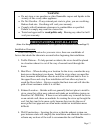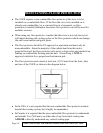
Page | 11
FREESTANDING INSTALLATION
Approved Venting Method 1
: Through the Wall
Generally the simplest installation
method, venting through the wall using
our AC-3000 kit (or similar venting
system) is also the preferred venting
method. It minimizes horizontal pipe,
allows the stove to be installed close to the
wall and keeps the clean-out tee on the
outside of the house, for ease of cleaning.
When installing any venting system, Type
L or Type PL pipe must be used and all
clearances to combustibles (listed by the
pipe manufacturer) must be strictly
adhered to.
Use the pipe manufacturer’s approved
thimble for passing through a combustible
wall, and maintain at least the minimum
clearances to combustibles.
Use an appliance collar where the pellet
vent connects to the exhaust output of the
pellet stove and attach the appliance collar to the exhaust blower output using three sheet
metal screws.
Secure the pellet vent to the outside of the house using a wall strap just below the 90 degree
elbow.
Seal each pipe connection joint with high temperature RTV Silicone, to ensure the system is
leak free (Check with the specific venting system manufacturer’s instructions before doing
so).
If the pellet vent pipe being used is not a “Twist Lock” system, three (3) sheet metal screws
are required at each pipe joint.
Connect the pellet stove to outside combustion air using the kit included with your stove or
using an alternative method, as described in the “Outside Air” section, on page 15.
This installation type can be modified for basement (Basement installations should always
be performed by a professional installer) or other installations wherein the tee and vertical
section of the pipe would be inside the home and the venting system would simply pass
horizontally through the thimble and then terminate.
Please Note:
Installation diagrams are for reference purposes only and are not drawn to scale, nor meant to be used as plans for each individual
installation. Please follow all venting system requirements, maintain the required clearances to combustibles, and follow all local
codes.
For high altitude installations (above 4,000 ft.), the vent pipe should be
increased from 3-inch (3”) to four-inch (4”).


















